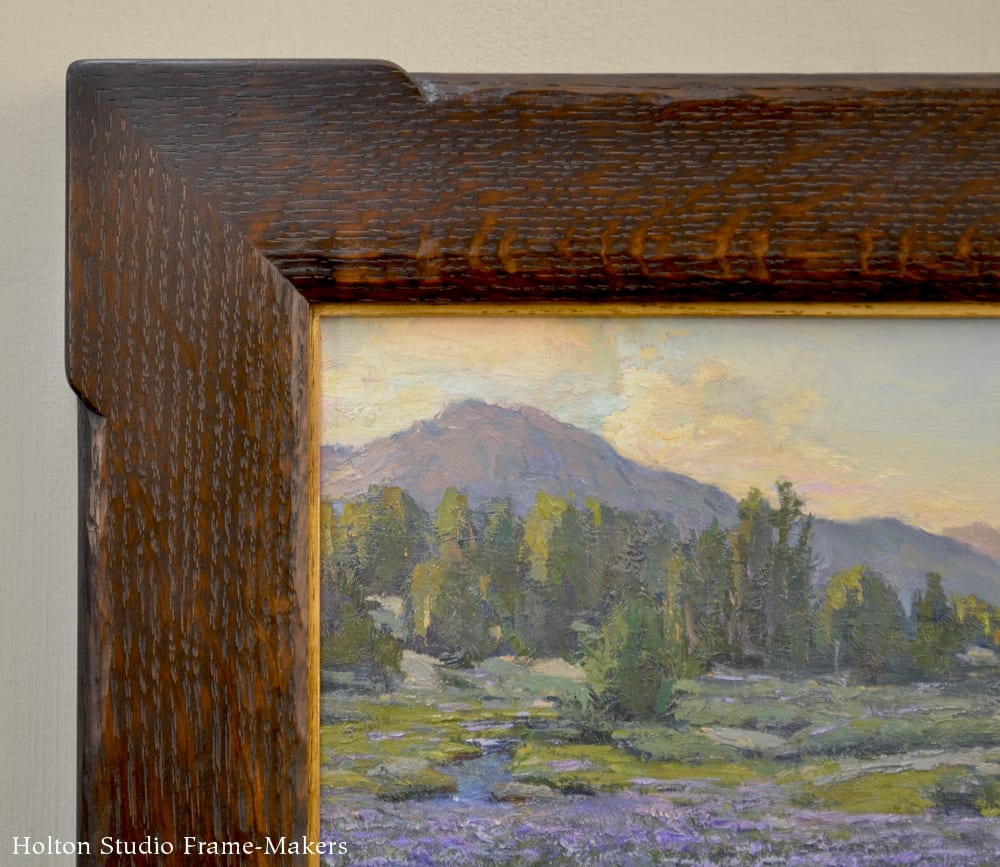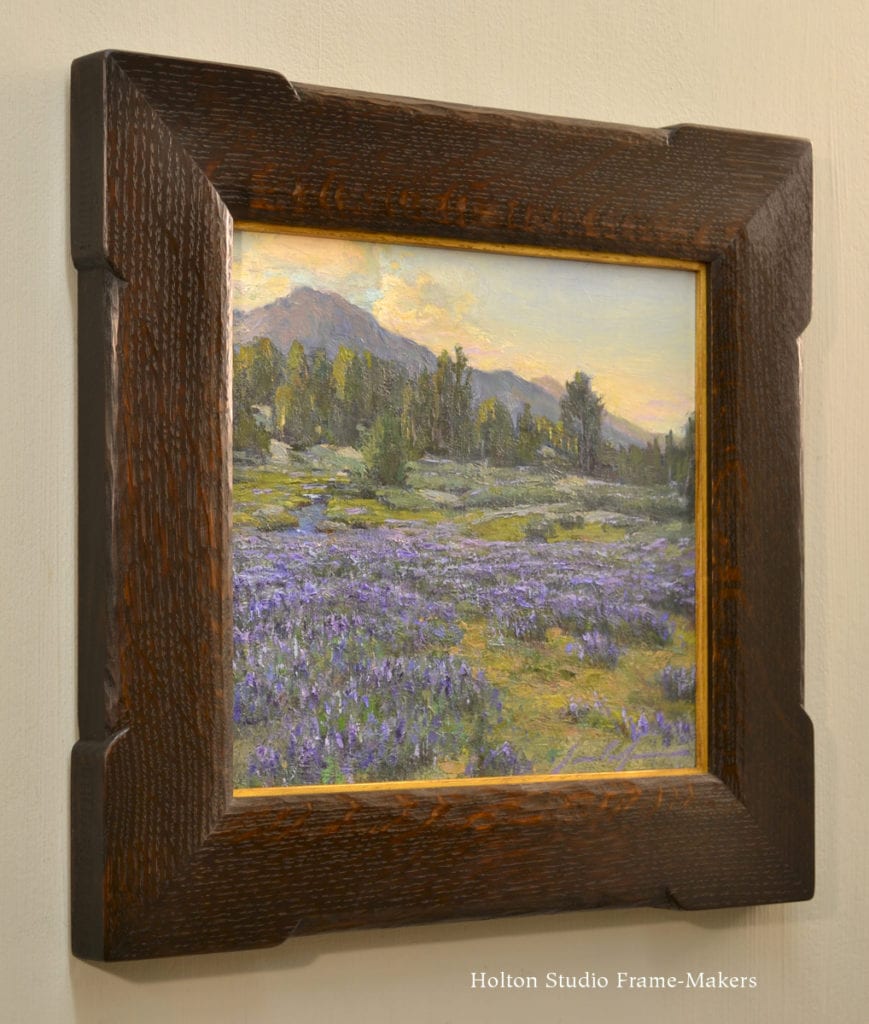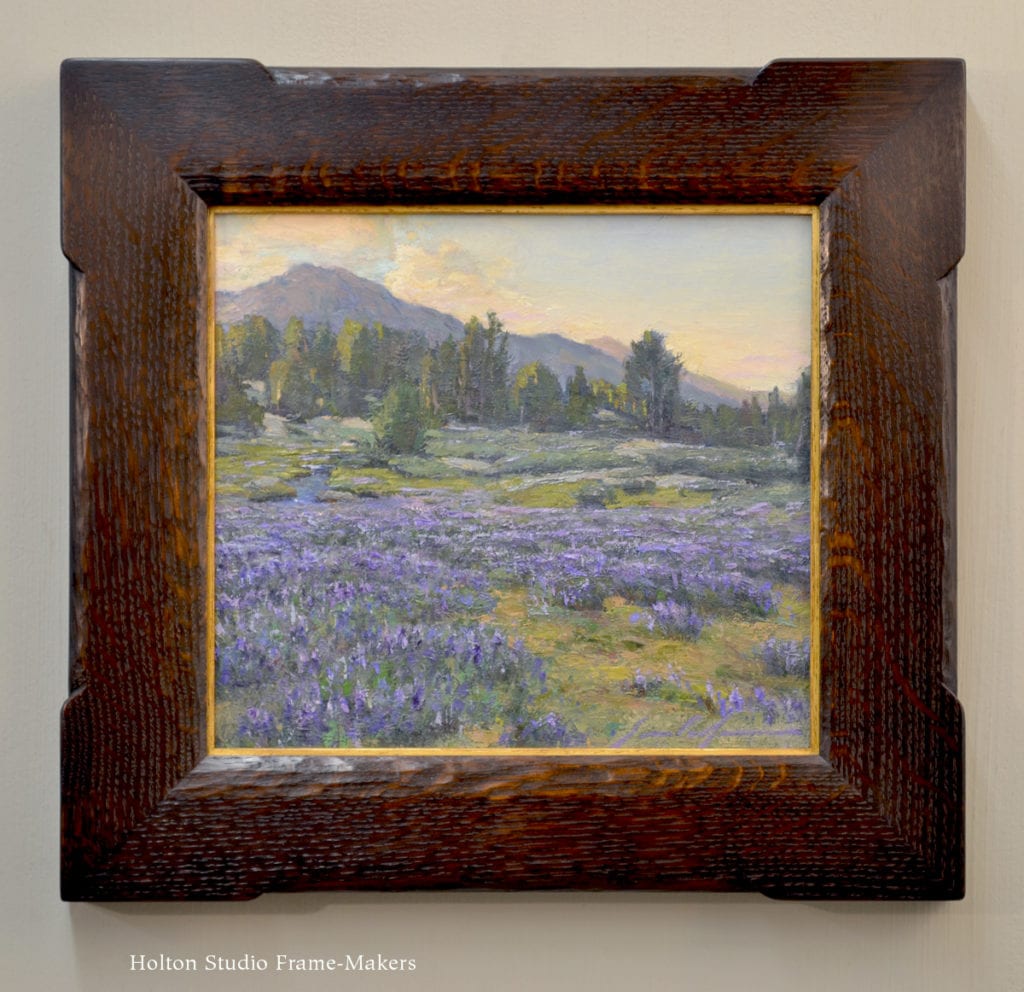This morning I completed the framing for “Beloved California, III”, our big annual all-gallery exhibit which opens today with a reception from 4 to 6. (I hope you’ll come.) The final piece framed is Ernesto Nemesio‘s “Sailor Lake Wildflowers” (oil, 9″ x 10″). It’s in a 2-1/4″ frame in stained quartersawn white oak (Dark Medieval Oak stain) with a 1/8″ (visible) gilt liner. The over all form is basically flat, with the sight edge given a carved subtle convex, or “cushion,” form that sustains the gentle undulations of the wildflower covered meadow. I also carved the back edge to a narrower quarter-round. In similar fashion to the frame for Bill Cone’s “Chickenfoot Inlet,” the corners are outset just 1/8″, but the way the corner detail intersects with the carved quarter round on the back edge gives it more emphasis.
This place in the Sierras, captured so beautifully by Ernesto, is something like paradise, and I’m reminded of the saying that when you die and meet God, God asks you, “So, how did you enjoy heaven?”
Among the things a frame does is reflect and inspire reverence and a desire to care for the creation and protect it (not only the particular part of it represented by the painting, but the whole of it on which each part depends). A painting is made to effect the world with that desire and spirit. To do that, it must, logically speaking, effect first its most immediate surroundings. A painting that’s allowed to inspire its immediate setting can then have immeasurable influence on the lives it touches, inspiring us to revere and protect things that matter. It represents itself the effective power of the picture, and seems to be formed by the picture.
As I write this, my office is bathed in a morning sun turned orange by the largest fire in California history, now over 70,000 acres near Chico, about 130 miles north of here. So in this light I look at these beautiful paintings, these appeals to our love for our landscape, and my heart is full, and heavy. What’s burning are trees, forests, homes and communities. The town of Paradise is lost—a microcosm, perhaps, of the entire state in its mythological reputation as dreamland and Garden of Eden. When we die and God asks, “So, how did you enjoy Paradise?,” what will we say? What if the question’s put this way: “So, did you care for Paradise?”
 The word “Beloved” used in the title of our show is an old word, not heard much anymore—an old-fashioned word, you might say. But why is it less current today than it’s been in the past? I’m not a linguist, and I’m sure there are many reasons experts could give for why words fall out of general usage. But no doubt one reason a word might fade is that the understanding and feeling that inspired it in the first place fades. Many things today are “loved.” They include flavors of ice cream and talk show hosts. But “beloved” is perhaps a word suggestive of a kind of love more powerful in reverence, constancy and devotion. It may be a type of relationship not of idle sentiment but of willingness to work and serve and sacrifice to maintain and cultivate good things to which we belong and are part of, and genuinely joined to. It may be a type of love that is fading as we each struggle to sustain deeper and truer connections to the world, and to all that people once described as beloved to them. It may be like care—a word that implies not feeling alone but effort.
The word “Beloved” used in the title of our show is an old word, not heard much anymore—an old-fashioned word, you might say. But why is it less current today than it’s been in the past? I’m not a linguist, and I’m sure there are many reasons experts could give for why words fall out of general usage. But no doubt one reason a word might fade is that the understanding and feeling that inspired it in the first place fades. Many things today are “loved.” They include flavors of ice cream and talk show hosts. But “beloved” is perhaps a word suggestive of a kind of love more powerful in reverence, constancy and devotion. It may be a type of relationship not of idle sentiment but of willingness to work and serve and sacrifice to maintain and cultivate good things to which we belong and are part of, and genuinely joined to. It may be a type of love that is fading as we each struggle to sustain deeper and truer connections to the world, and to all that people once described as beloved to them. It may be like care—a word that implies not feeling alone but effort.
What can we do in the face of such devastation brought upon ourselves by our own carelessness toward the earth but renew our commitment to a true, faithful relationship to the earth, and the particular places on the earth where we live—a relationship often once evoked by the good old word “beloved.” In our time that’s left, what can we do but remember our responsibility to use our arts, our unique human powers to help in the work of creation, as William Morris said. As I have many times before, I lean on Morris’s summation of his whole understanding and teaching of the arts:
It is indeed in…the belief in the beneficent progress of civilisation, that I venture to face you and to entreat you to strive to enter into the real meaning of the arts, which are surely the expression of reverence for nature, and the crown of nature, the life of man upon the earth… And in all I have been saying, what I have been really urging on you is this–Reverence for the life of Man upon the Earth: let the past be past, every whit of it that is not still living in us: let the dead bury their dead, but let us turn to the living, and with boundless courage and what hope we may, refuse to let the Earth be joyless in the days to come.
Please join us this evening for the opening from 4 to 6. Or if you can’t make it to the opening, be sure to stop by before December 29 to see “Beloved California, III”, this fine exhibit of true reverence and devotion. It will restore to your heart knowledge of the heavenly beauty of the land where we live and the meaning of our lives that are a part of it.

Beautiful painting and I just love the modified keyed corner and chip carved frame.